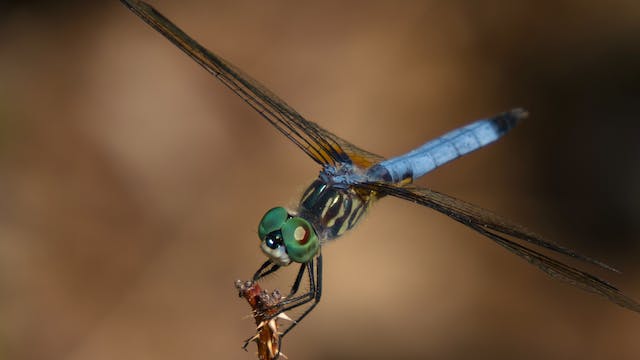
Why did prehistoric insects grow so big? Because there was a lot more oxygen in the atmosphere and there were no birds.
The largest insect in the world today is the Phryganistria chinensis, which is a stick insect. It is 64 cm long. The insect with the largest wingspan is the White witch moth, which has a wingspan of about 30 cm. Worth a mention, purely because I love its name, is the wētā from New Zealand. It is a cricket about 20 cm long and weighs about 70g. In English, its name means “god of ugly things”! They used to grow even bigger but, unfortunately, when rodents were introduced into New Zealand on ships from Europe, they all but decimated the population.
The largest insect that has ever lived was probably a dragonfly. 300 million years ago, griffenflies (meganisoptera), which are a type of dragonfly, had wingspans of over 70 cm. That would make it about the same size as a seagull. The griffenfly wasn’t the only large insect at the time and there may even have been larger ones. It is very difficult to know because experts can only go on the fossil record, and it is quite rare to find complete fossils of insects. Insects, even bigger ones, are made of many delicate parts that do not lend themselves to fossilization. Bits of wings or bits of bodies are often found, and paleontologists have to extrapolate the size of the insect.
So, why was the griffenfly able to grow so large and why can’t modern insects grow that large. There are three reasons. The first two reasons are both because of the oxygen content in the atmosphere. Today, 21% of Earth’s atmosphere is made up of oxygen. Any more or less than that and we have trouble. We cannot survive for long at the top of Everest because of the lack of oxygen and we could not survive for long in an atmosphere of more oxygen. Between 500 and 300 million years ago, up to 31% of the atmosphere was oxygen. The rise and fall of these giant insects coincides exactly with the rise and fall of the level of oxygen. High oxygen levels in the atmosphere is the reason why insects can be bigger, but it is also the reason why they have to be bigger.
Insects don’t have lungs. They breathe through openings in their exoskeleton called spiracles. Oxygen enters through the spiracles and goes down tubes called tracheae, heading to where it is needed. Oxygen can only travel a certain distance down these tracheae, which limits the size of insects. For oxygen to be able to travel further down the tracheae, there needs to be more oxygen in the atmosphere. The largest insects are right at the limit of 21% oxygen in the atmosphere. 300 million years ago, oxygen in the atmosphere was over 30%, which meant insect’s tracheae could be longer and they could be bigger. If the percentage of oxygen falls, they will need to be smaller.
However, they had to be bigger, because too much oxygen is toxic. Insects are able to open and close their spiracles, reducing the amount of oxygen that enters their bodies. Insect larvae are not able to do this. They absorb oxygen trough their skin and they cannot control how much they take in. The only way they can cope with such high levels of oxygen is to grow bigger. In the same way as with heat loss, the amount of of oxygen they absorb is related to their size because the larger an animal is the smaller their volume to surface area is. Larger insect larvae absorb less oxygen relative to their body mass. So, larvae had to be bigger because there was more oxygen in the atmosphere and adult insects could be bigger because there was more oxygen in the atmosphere.
The third reason they could be bigger is because birds had not evolved yet. The number of large insects rose and fell with the amount of oxygen in the atmosphere, but they began to decline and virtually disappeared starting 150 million years ago. This coincides with the evolution of the first birds. Dinosaurs that could fly appeared approximately 150 million years ago and evolved into birds. They were very fast and could maneuver very quickly. Large insects cannot turn as quickly, and they could not escape these new predators. Smaller insects had a distinct advantage because they could hide more easily, and they could turn more quickly. This advantage meant that more smaller insects survived and passed on their genes. The giant insects slowly disappeared. And this is what I learned today.
Photo by Sean Brannon: https://www.pexels.com/photo/dragon-fly-18854474/
Sources
https://news.ucsc.edu/2012/06/giant-insects.html
https://en.wikipedia.org/wiki/Meganisoptera
https://thedragonflywoman.com/tag/fossil-insects/
https://theconversation.com/the-rise-and-fall-of-oxygen-18954
https://askabiologist.asu.edu/how-insects-breathe
https://www.goodrx.com/conditions/anesthesia/oxygen-toxicity
